Thanksgiving Feast Favorites
Air Date: Week of November 17, 2023

The Living on Earth cast and crew shares their family recipes for Thanksgiving dinner. (Photo: Karolina Grabowska, Pexels, CC)
To kick off this Living on Earth Thanksgiving special, members of our crew share a few laughs and our favorite Thanksgiving recipes, from pumpkin soup to chouriço stuffing to desserts made with leftover pie crust.
Transcript
CURWOOD: From PRX and the Jennifer and Ted Stanley Studios at the University of Massachusetts, Boston this is a special Thanksgiving edition of Living on Earth. I’m Steve Curwood.
[MUSIC: Roy Hargrove, Christian McBride, “Frosty The Snowman” on Jazz For Joy: A Verve Christmas Album, The Verve Music Group.]
CURWOOD: Thanksgiving marks the beginning of the holiday season. So families and friends are gathering around the feast to share of staples as well as some less common traditions. And we've gathered some of the Living on Earth folks together to get a taste of those recipes. And with me now, of course, is Jenni Doering.
DOERING: Hi, Steve. We've got some familiar voices and some behind the scenes folks from our crew as well. And Aynsley O'Neill's got us covered with a starter course. Is that right?
O'NEILL: Yeah, I wanted to share my mother's pumpkin soup recipe, by way of Martha Stewart. You just cut up you know, two to three cups of pumpkin, simmer it with onion, garlic, salt, pepper, thyme, in either chicken or veggie broth. When that's all nice and tender, you puree the mixture, you got to be careful there because it's really hot, so be gentle with it. You return the pureed soup to the pot, and then you add some heavy whipping cream. Warm it first, so it doesn't curdle, and you serve it. And the Martha Stewart version suggests using a little mini pumpkin to serve it in.
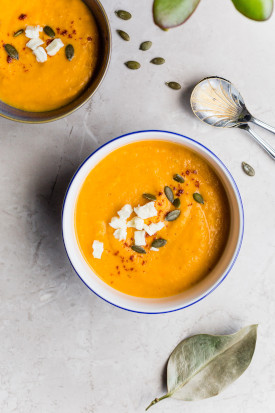
Pumpkin soup makes a perfect starter course for Thanksgiving dinner. (Photo: Cala, Unsplash, Unsplash License)
PANDELIDIS: Aww!
O'NEILL: But we use mugs so that the family can walk around and mix and mingle before we sit down to the main course.
DOERING: How cute.
CURWOOD: And if anyone's listening to us wondering that they didn't scribble down this recipe fast enough. It can all be found on the Living on Earth website, LoE.org. So hey, what's next, Jenni?
DOERING: Well, I think we've got Naomi Arenberg here and she picks the music every week. So Naomi, you've got some cranberries for us?
ARENBERG: I've got the reminiscence. I'm from a cranberry growing family. Both my father and grandfather were cranberry growers. And so that's the special part of Thanksgiving for me. You can use them, I think, in almost anything. I've got pie in front of me. And of course there's the sauce. I make it pure with just cranberries. You don't need to add water in the pot, but you can. A splash of home squeezed orange juice, a little bit of sugar. Always cut back on the sugar than any recipe has. Because you can always add it, but you can't take it out. And so just simmer that away until the cranberries are all popping in the pan. And be sure to let it cool thoroughly and sit for a day or more. And people will rave about your cranberry sauce. And I think that adds a bright, nice color to the table, whether it's Thanksgiving or any other holiday.
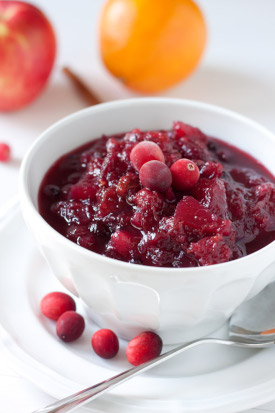
Music Coordinator Naomi Arenberg suggests adding fresh squeezed orange juice to make the perfect cranberry sauce. (Photo: Emily Carlin, Flickr, CC BY-NC-ND 2.0)
DOERING: Yeah. Oh, man that, that cranberry sauce when it's bubbling away and making those popping sounds. It smells incredible too.
CURWOOD: Yeah, that's great. And I do a version of that: cranberries, just a little bit of water in the cranberries, and maple syrup where I am in New Hampshire, instead of conventional sugar and it tastes delicious.
DOERING: And you tap those trees yourself. Right, Steve?
CURWOOD: Well, we have historically. My mom has. I haven't recently been tapping them, but our neighbors do and it is delicious. Also, just when it comes to the stuffing, I also put cranberries in the stuffing that I make. I have to confess that not everybody likes that in my family. So I make two versions of stuffing: with the cranberries and then those without.
DOERING: So speaking of stuffing, I think our Technical Director Jacob Rego who is usually not heard, but he does all the work behind the scenes on this broadcast and podcast. I think he wanted to tell us about stuffing as well. What you got Jake?
REGO: Yeah, a recipe my family enjoys every year is Portuguese stuffing. It's a secret family recipe. But its key ingredient is a Portuguese sausage called chouriço. We never seem to have any leftovers, though, because it's a family favorite.
O'NEILL: Ooh, tasty.
CURWOOD: Mm, mm! That's so good. I've had food from where your family's from around New Bedford, Massachusetts. They put chouriço in almost everything and it makes it delicious. All right, let's turn now to our Director of Advancement and Program Strategy, Mark Kausch, who's famous for playing the double bass in symphony orchestras, but you have something else that's double for us today, Mark, I think?
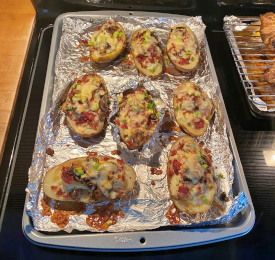
Twice-baked potatoes can hold any toppings you like. Mark Kausch, the Living on Earth Director of Advancement and Program Strategy, enjoys his with scallions and bacon. (Photo: Jo Ziimny Photos, Flickr, CC BY-NC-ND 2.0)
KAUSCH: Yes, double in a manner of speaking. Correct. At the front end of the pandemic. I reached out to my dad to say, hey, we're going to be trapped here in Minnesota, just the two of us, my wife and I. Can we have your twice baked potato recipe? He said sure. And it actually was one that he'd made up himself. It wasn't something that he found in a recipe book. And the more we got talking about it, the more it dawned on me that basically twice baked potatoes are kind of like making pizza or making nachos. You can kind of do whatever you want. Bake the potatoes, carve out the potatoes. Keep the potato skins as your bowls for later on. And then his recipe mashes in a bunch of butter, some scallions, bacon bits, with apologies to the vegans and vegetarians out there. But those are optional. And then you put it all back into the potato skins, and bake it for another 15-20 minutes. And I thought, well, this doesn't sound so hard, I can totally do this. And I was absolutely stunned at how complicated it turned out to be. And sadly, how I just couldn't quite do quite as well as dad did with his every-year recipe. I'm off the hook now because he's back at it. And I'm looking forward to his version and hoping that someday I'll do as well as he does. So, yeah.
O'NEILL: You'll have to shadow him in the kitchen this time around
KAUSCH: There we go. Good thought.
PANDELIDIS: Dad knows best!
CURWOOD: Yeah, sounds like twice baked potatoes will be enough for a whole meal. Really, that could be the main entree.
KAUSCH: Yeah, I think you're absolutely right, Steve. And it's, it's always fascinating to me how more often than not, it's the side dishes that are the most fun at Thanksgiving, for sure.
DOERING: And some of the most filling. Well, I hope you still have some room in your stomachs because our Living on Earth Contributor who looks beyond the headlines for us each week is here too. Peter Dykstra, what are you salivating over this Thanksgiving?
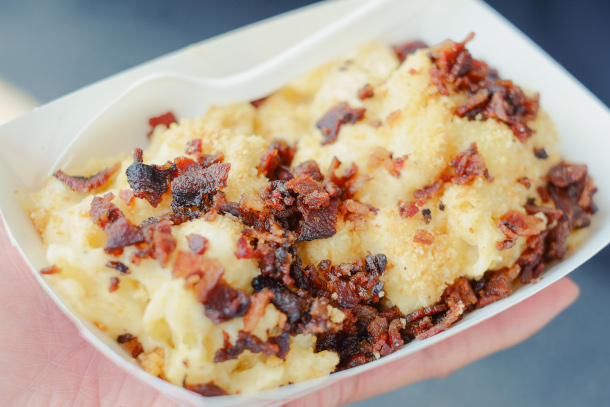
Living on Earth Contributor Peter Dykstra also uses bacon to top his Thanksgiving mac and cheese. (Photo: Daremoshiranai, Flickr, CC BY-NC 2.0)
DYKSTRA: Well, I'm not salivating. I'm still chewing on all of the prior recipes that we've heard. But I come from a long line of meat-eating, environmentally-hypocritical relatives. My contribution usually is just good old mac and cheese. But with bacon in it. It's simple elbow mac. I tried it one year with gluten-free elbow mac, not realizing that gluten-free elbow macaroni turns basically into mashed potatoes when you try and use it. Cheddar cheese, because you don't want the four cheese stuff. Because cheddar cheese will out-taste just about anything. And we top it off with a lot of crumbled bacon. And it's usually the first thing to disappear at our table full of carnivores, with occasionally environmentally-bankrupt and hypocritical means at the dinner table.
CURWOOD: Heh, okay. Hey, Jenni, what about you?
DOERING: All right, well, I hope you still have room because I love green bean casserole. And I have to say I used to hate the stuff that came from the can. You know, for me, it was these green beans that were cooked until death. So they were like gray, and then that can of mushroom soup from a can.
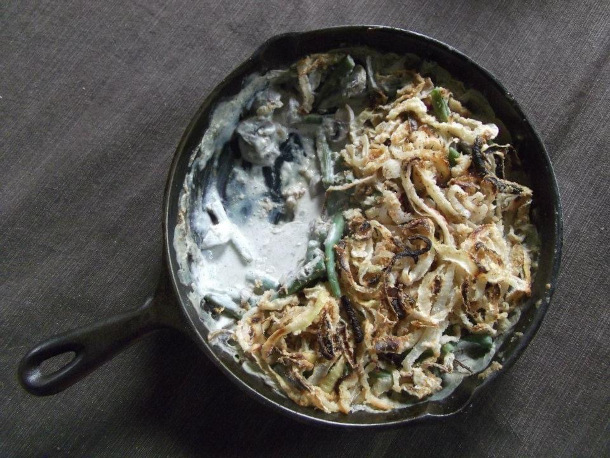
Jenni Doering makes her green bean casserole from scratch, following the Alton Brown recipe. (Photo: Jenni Doering)
PANDELIDIS: Ugh.
DOERING: But now I'm completely obsessed with making it from scratch. And Alton Brown has an amazing recipe where in a big cast iron pan, you put all this stuff together and you first do blanched green beans. Then you saute mushrooms into a luscious and delicious roux. And then you top that all with crispy, thin sliced onions and it is just delicious.
CURWOOD: How does it sound to you Peter?
DYKSTRA: It sounds like something I can't eat, with all due respect. I'm allergic to all manner of beans. Green beans, pinto beans, lima beans, string beans. So if we eat any of those things in a restaurant, I'll have to order myself an ambulance.
CURWOOD: Oh my goodness.
DOERING: Oh, dear. Well, Steve, we're hearing some to-die-for Thanksgiving recipes from the Living on Earth crew. But we haven't even gotten to the turkey yet.
CURWOOD: All right. You know, only the strictest vegans and vegetarians omit the turkey at Thanksgiving. It's that one time of year where maybe people make the exception. And a succulent delicious turkey with rice stuffing is amazing. And I learned from my mother-in-law that you can cook a turkey at a very low temperature, just a little over 200 degrees, overnight to keep it really juicy and not have the top of it dry out. And of course then you put in that stuffing with the cranberries and it's, it's amazing. As a youngster where we live in New Hampshire, the neighbor would grow turkeys. And so we will go by, select the live turkey that we wanted and then it would show up in our kitchen, all fully dressed. And that took me a little while as a kid to make the connection. And when I did I was kind of sad, but you know if you're gonna eat meat, you got to take responsibility for the process. Okay, well what do you say Jenni? You're ready for dessert?
DOERING: I'm ready. I mean, I might be bursting after dessert, but let's try.
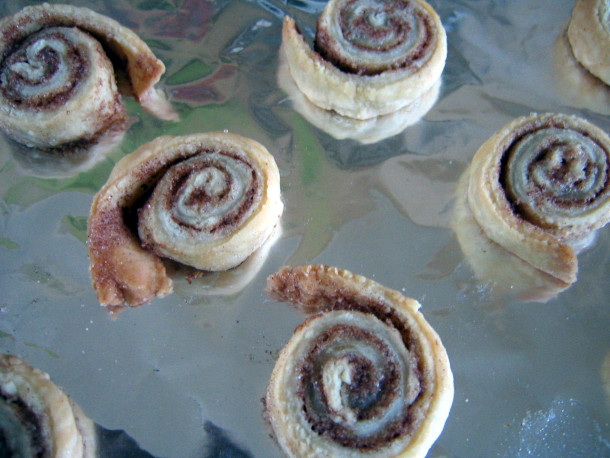
An easy and tasty way to recycle your pie crust scraps is to brush them with melted butter, cinnamon sugar, and roll them up before baking. (Photo: Jessica Langlois, Flickr, CC BY-NC-ND 2.0)
CURWOOD: Okay.
DOERING: Kicking us off with dessert. I think we've got El Wilson. One of the newest additions to the Living on Earth crew and a producer here. What have you got, El?
WILSON: Yeah, in my family we use the leftover pie crust to make cinnamon scraps. All you do is roll the crust into a sheet, cover it with melted butter. And then sprinkle it with cinnamon and sugar. You roll it up, cut it into pieces, and throw in the oven. They come out looking like mini cinnamon rolls.
O'NEILL: Mmm!
CURWOOD: Oh, yeah, that sounds really tasty. I'll have to try that. Now, Sophia Pandelidis, another one of our producers, I think you have a related dessert in your family repertoire. N'est-ce pas?
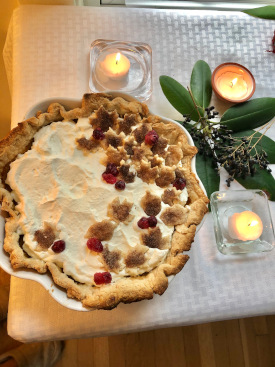
Sophia Pandelidis’ family takes their pie crust scraps and turns them into decorative pie toppers. (Photo: Courtesy of Sophia Pandelidis)
PANDELIDIS: Yeah, that's funny, El. So my family does almost the same thing. We roll out the leftover pie dough and sprinkle it with cinnamon sugar, too. But then instead of making it into cinnamon rolls, we actually cut it out in fun shapes, like cookies, we're talking leaves or pumpkins. And then we use those little shapes to decorate our pies. So it's fun and tasty.
WILSON: Cute!
O'NEILL: I love that.
CURWOOD: Yeah, that gets to play with the nice thing about this feast part of the holiday, getting together with folks, is being together, cooking and making things. It's not just a meal. It's a gathering.
PANDELIDIS: Yeah. And it's an artistic process too.
DOERING: All right, so we've got all this leftover pie crust. What are some of our favorite pies to make out of that pie crust?
ARENBERG: Hmm. Don't get my mouth watering, please. I'll drip on the microphone. For me growing up as the daughter and granddaughter of cranberry growers, you can make a delicious, open faced pie, please because it glistens. Even the next day. When you first take it out of the oven, invite everyone to circle around and look at this glistening creation. And then the next day, the color settles down. It stays really shiny. It's almost a stained glass window there.
O'NEILL: Ooh, beautiful.
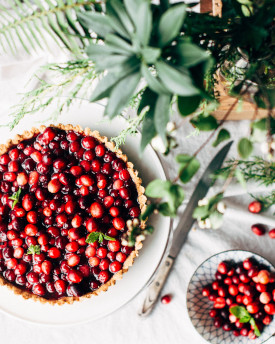
An open-faced cranberry pie. (Photo: Jennifer Pallian, Unsplash, Unsplash License)
DOERING: Wow.
ARENBERG: Yeah, too pretty to eat? Nah.
DOERING: Maybe a la mode, perhaps? Bit of vanilla ice cream?
ARENBERG: Yes, absolutely.
DOERING: It's my favorite way to eat apple pie.
CURWOOD: Any kind of pie! Well, thank you, Naomi. And by the way, speaking of pie, I should mention my grandmother's pumpkin pie, which was part of a very frugal Depression era way of thinking. If there are going to be pumpkins for decorating, they then need to be recycled into the pies that are going to happen at the holiday season. And grandma had a nice garden. Probably it was a victory garden for World War Two at our house, and she grew her own pumpkins. But I guess not all pumpkins are made equal for this sort of thing.

Sugar pumpkins are ideal for making pumpkin pie. (Photo: Diliara Garifullina, Unsplash, Unsplash License)
ARENBERG: Correct. There is one variety that you often can find just in a normal, run-of-the-mill grocery store called sugar pumpkins that are grown to be used in a pie or in cooking.
CURWOOD: Probably explains why later in life when I tried to make pumpkin pie with ordinary pumpkins, they were kind of stringy and watery. Of course, you add enough sugar, you've got a pie. But now I know what grandma's secret was.
DOERING: So I think we're just about wrapped up here. But we have one more sweet thing to finish this out. Jacob, I think you've got something to offer.
REGO: Yeah, dessert that is required for our family's Thanksgiving is a homemade chocolate fudge. You can find the recipe on the back of a jar of marshmallow fluff. It's delicious mix of sugar, chocolate, fluff, butter, vanilla and walnuts.
ARENBERG: Mm, mm!
O'NEILL: My family, we also always have a chocolate course. Now we don't make it from scratch. But some chocolates, some clementines, some eggnog is the perfect way to wrap it up.
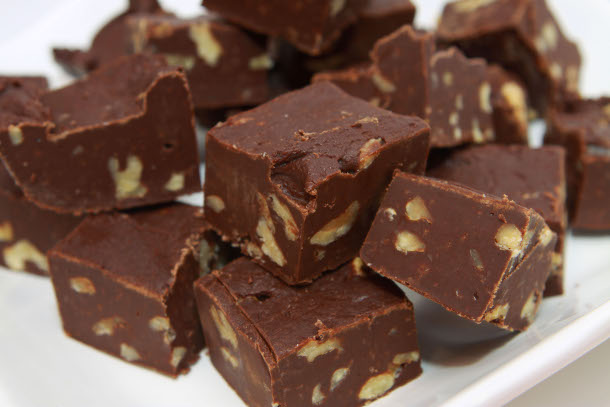
Our Technical Director Jacob Rego’s family loves making homemade fudge for Thanksgiving. (Photo: Rachel, Flickr, CC BY-NC 2.0)
CURWOOD: Ooh, and maybe a taste of rum for some people?
DOERING: Yeah, it depends what kind of eggnog you're drinking.
CURWOOD: Well, Jenni, I guess that's it. So we better get on with the cooking, right? Because this is not a quick meal to put together.
DOERING: Yeah, I think this might take a few days to create everything. All this sounds like a recipe for a food coma for me at least.
CURWOOD: There you go. And if you've been listening to us, and you're thinking, "well, what about..." just go to our website and you can see all these recipes there. And if you have any luck write to us about what works well in your kitchen.
ALL: Happy Thanksgiving!
Links
Living on Earth wants to hear from you!
Living on Earth
62 Calef Highway, Suite 212
Lee, NH 03861
Telephone: 617-287-4121
E-mail: comments@loe.org
Newsletter [Click here]
Donate to Living on Earth!
Living on Earth is an independent media program and relies entirely on contributions from listeners and institutions supporting public service. Please donate now to preserve an independent environmental voice.
NewsletterLiving on Earth offers a weekly delivery of the show's rundown to your mailbox. Sign up for our newsletter today!
 Sailors For The Sea: Be the change you want to sea.
Sailors For The Sea: Be the change you want to sea.
 The Grantham Foundation for the Protection of the Environment: Committed to protecting and improving the health of the global environment.
The Grantham Foundation for the Protection of the Environment: Committed to protecting and improving the health of the global environment.
 Contribute to Living on Earth and receive, as our gift to you, an archival print of one of Mark Seth Lender's extraordinary wildlife photographs. Follow the link to see Mark's current collection of photographs.
Contribute to Living on Earth and receive, as our gift to you, an archival print of one of Mark Seth Lender's extraordinary wildlife photographs. Follow the link to see Mark's current collection of photographs.
 Buy a signed copy of Mark Seth Lender's book Smeagull the Seagull & support Living on Earth
Buy a signed copy of Mark Seth Lender's book Smeagull the Seagull & support Living on Earth

